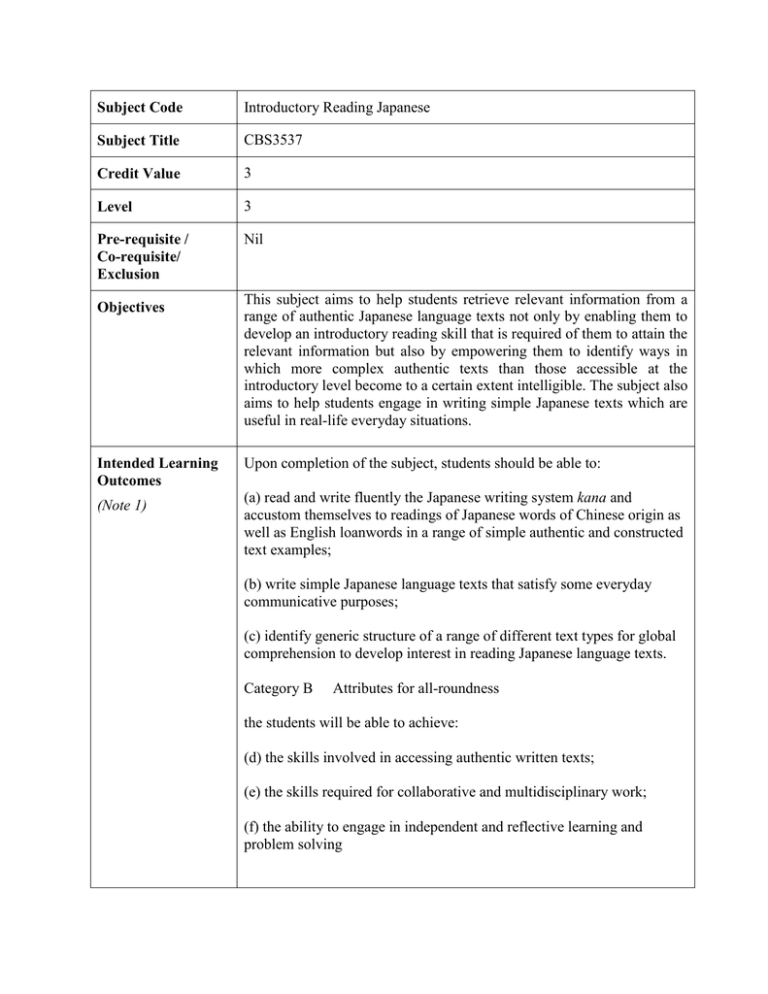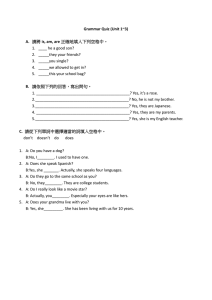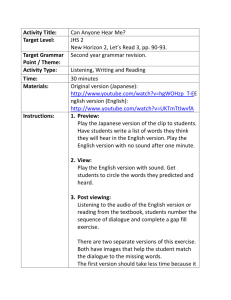CBS3537
advertisement

Subject Code Introductory Reading Japanese Subject Title CBS3537 Credit Value 3 Level 3 Pre-requisite / Co-requisite/ Exclusion Nil Objectives This subject aims to help students retrieve relevant information from a range of authentic Japanese language texts not only by enabling them to develop an introductory reading skill that is required of them to attain the relevant information but also by empowering them to identify ways in which more complex authentic texts than those accessible at the introductory level become to a certain extent intelligible. The subject also aims to help students engage in writing simple Japanese texts which are useful in real-life everyday situations. Intended Learning Outcomes Upon completion of the subject, students should be able to: (Note 1) (a) read and write fluently the Japanese writing system kana and accustom themselves to readings of Japanese words of Chinese origin as well as English loanwords in a range of simple authentic and constructed text examples; (b) write simple Japanese language texts that satisfy some everyday communicative purposes; (c) identify generic structure of a range of different text types for global comprehension to develop interest in reading Japanese language texts. Category B Attributes for all-roundness the students will be able to achieve: (d) the skills involved in accessing authentic written texts; (e) the skills required for collaborative and multidisciplinary work; (f) the ability to engage in independent and reflective learning and problem solving Subject Synopsis/ Indicative Syllabus Week 1 Content Introduction 2-4 5-7 Reading & Writing Kana Recommending text: advertisement, warning etc. Doing text: invitation letters etc. Sharing text: personal email, conversation [chat, gossip etc.] Review 8-10 11-13 14 Teaching/Learning Methodology (Note 3) Remark Reading material to be provided Quiz 1 (Week 3) Quiz 2 (Week 7) Quiz 3 (Week 10) Exam The subject is composed of two parts: lectures offer learning content that is expanded through various activities and tasks in the subsequent seminars. Mode of teaching and learning is highly interactive, involving students in pair/ group work and discussion in which learning tasks are collectively completed. Where appropriate, students are expected to present their understanding of the content of relevant texts individually and/or in pair/group. Different modes of learning not only enhance their language skills specified in the Intended Learning Outcomes but also enable them to deal with problem solving individually and collaboratively. Assessment Methods in Alignment with Intended Learning Outcomes Specific assessment methods/tasks % Intended subject learning outcomes weighting to be assessed (Please tick as appropriate) a (Note 4) b 1. Quiz 20 % √ 2. Homework 20 % √ √ 3. Writing task 15 % √ √ 4. Examination 30 % √ 5. Active class participation 15 % Total 100 % c d e f √ √ √ √ √ √ √ √ Explanation of the appropriateness of the assessment methods in assessing the intended learning outcomes: The assessment tasks (1), (3) & (4) help identify students’ incremental development of reading and writing skills, and (2) & (5) observe students’ independent and reflective learning processes. Student Study Effort Required Class contact: Lecture 14 Hrs. Seminar 28 Hrs. Other student study effort: quiz and homework preparation (2 hours x 14 weeks) 28 Hrs. review and preview including exam and written task (3 hours x 14 weeks) 42 Hrs. Total student study effort Reading List and References 112 Hrs. Reading List: There is no set textbook for this subject. A compilation of authentic and constructed Japanese written texts will be used and provided throughout the semester. References: Makino, S. and Tsutsui, M. 1986. A dictionary of basic Japanese grammar. Tokyo: The Japan Times. [Word and phrase-based reference grammar of Japanese] Makino, S. and Tsutsui, M. 1995. A dictionary of Intermediate Japanese Grammar. Tokyo: The Japan Times. [Word or phrase-based intermediate reference grammar of Japanese] Martin, Samuel E. 1975. A reference grammar of Japanese. Rutland, Vermont & Tokyo, Japan: the Charles E. Tuttle Company, Inc. [Most comprehensive coverage of the grammar of Japanese written in English: Romanization makes it difficult to access] Matsumoto, Masumi . 2008. Textbook of Kana 從零開始學日語. Taiwan: Dah Hsin Publishing House. Maynard, Senko K. 1990. An Introduction to Japanese Grammar and Communication strategies. Tokyo: The Japan Times. [Reference grammar based on usage] * For learning Kana, many free online learning resources including games are available for anyone who wishes to learn both Hiragana and Katakana effectively, for example: http://www.learn-hiraganakatakana.com/. Syllabus prepared by Dr. Kazuhiro Teruya



